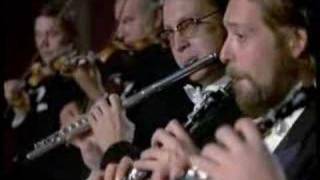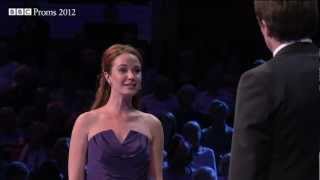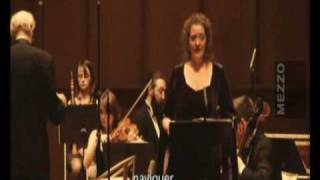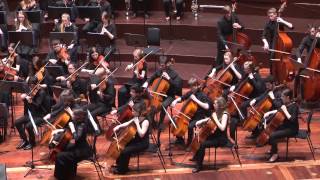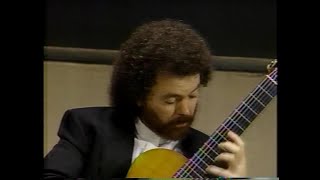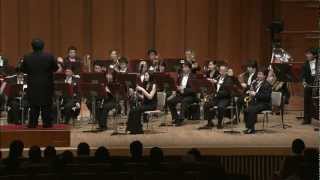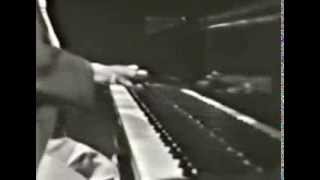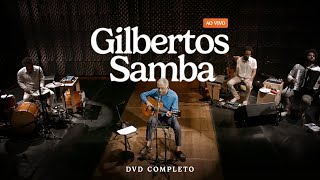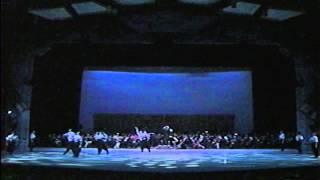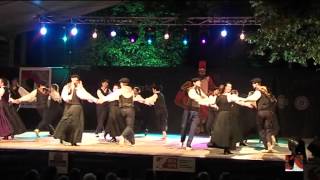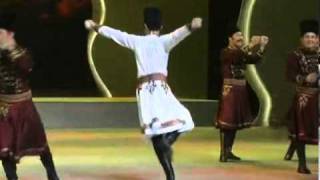Valentine's Day is celebrated on February 14, the day of lovers.
Recommended music videos for initiation to classical music
Jean-Philippe Rameau (1683–1764) was a French composer, harpsichordist and music theorist, highly influential in the Baroque era, replacing Jean-Baptiste Lully as the dominant composer of French opera. Rameau 's lyrical work constitutes the bulk of his musical contribution and marks the apogee of the French Baroque with his best-known work, the opera-ballet Les Indes galantes . Despite all this, his lyrical works were forgotten until the mid- 20th century as they benefited from the movement of rediscovery of early music; his harpsichord works, however, were ever present. Rameau is generally regarded as the most important French musician before the 19th century ; he died in 1764 at the age of 81.
Jean-Philippe Rameau 's Harpsichord Concerto Pieces , published in 1741, are the composer's only example of chamber music and were composed in his mature years; they are much later than his solo harpsichord works, his religious music, and then his first lyrical masterpieces. In the preface, Rameau specifies: “These pieces performed on harpsichord alone leave nothing to be desired: one does not even suspect that they are capable of any other pleasure.”
The Lapoplinière , which we are presenting today, is the first piece from the Third Concerto of the Pieces for Harpsichord in Concerts written for harpsichord ( Béatrice Martin ), violin ( Patrick Cohën-Akenine ) and viola da gamba ( Nima Ben David ).
Wolfgang Amadeus Mozart (1756-1791) is considered one of the three giants of musical composition along with Bach and Beethoven . A child prodigy born in Salzburg (Austria), at the age of six he mastered the keyboard and the violin and began to compose. His father, Leopold, took him on exhausting tours of different European courts. A prolific composer (more than 600 works written from the age of five until his death), he cultivated all kinds of musical genres: piano works, chamber music, symphonies, concertante works, choral works, operas... each and every one of them, masterpieces of their genre. His operas The Magic Flute, Don Giovanni, Così fan Tutte, and The Marriage of Figaro are among the 10 most performed operas in the world. He died in Vienna at the age of 35.
The catalogue of Mozart's works or Köchel Catalogue ( Köchel Verzeichnis, in German) was created by Ludwig von Köchel in 1862 and lists the musical works composed by Wolfgang Amadeus Mozart . Each of Mozart 's works is designated by a number preceded by the abbreviation K. or KV ; a number that designates the chronological order of its creation and that is actually valid for the majority of the works; however, in its first edition, works by other authors appear erroneously attributed to Mozart , and omits other authentic works that had not yet been discovered.
Symphony No. 41 in C major, K. 551, Jupiter , is the last symphony that Mozart composed. It is believed that it was the music impresario Johann Peter Salomon who added the epithet “ Jupiter ” to the symphony, which is divided into four movements, implying that it had identical characteristics to that of the supreme and triumphant god.
Today we offer its first movement (Allegro Vivace) in a version by the Vienna Philharmonic conducted by the Austrian maestro Karl Bohm (1894-1981), universally regarded as one of the best conductors in the world of his time. Critics always stressed the rhythmic precision of Böhm 's conducting and it was said that with him, one could always perceive the value of the notes; while others understood that he conducted with an excessively "metronomic" baton.
Franz Liszt (1811-1886) was a brilliant Hungarian pianist and successful composer whose works have survived through the ages; works for solo and concertante piano, as well as orchestral works among which his symphonic poems stand out, a musical form of which he was the progenitor. Liszt 's father, an amateur musician, gave him his first piano lesson at the age of seven. In October and November 1820, at the age of nine, he appeared in concerts in Sopron and Bratislava . His father arranged for Franz to be introduced to the Court of the House of Esterházy as a child prodigy. He was famous throughout Europe during the 19th century ; his contemporaries claimed him to be the most technically advanced pianist of his time and the greatest of all time.
The nocturne is a piece of vocal or instrumental music with a sweet melody and free structure. The name "nocturne" was first given in the 18th century to a piece played at evening parties. In its most common form (that is, as a single-movement piece generally written for a piano solo), the genre was cultivated mainly in the 19th century . The most famous exponent of this music was Frédéric Chopin , who wrote 21 works in that genre.
Liebesträume (Love Dream) is a set of three nocturnes written for piano by Franz Liszt , of which No. 3, which we suggest today, is the best known; its interpretation is currently performed by the pianist Vanessa Benelli (1987).
Leonard Bernstein (1918 - 1990), American composer, pianist and conductor, was the first world-famous American- born conductor. He is widely regarded as one of the world's greatest conductors and is best known for his direction of the New York Philharmonic Orchestra , his television Concerts for Young People from 1958 to 1972, and his varied and exquisite compositions. He was also a pivotal figure in the modern revival of the music of Gustav Mahler , a composer in whom he was passionately interested. As a composer he wrote piano music, chamber music, choral music, church music, numerous stage works for ballet, film, opera, and musicals, and numerous orchestral works.
West Side Story is a musical with a book by Arthur Laurents , music by Leonard Bernstein , and lyrics by Stephen Sondheim . Loosely based on William Shakespeare 's Romeo and Juliet , the action takes place in a New York neighborhood in the mid-1950s between two youth gangs of different ethnicities: the Jets (of European roots) and the Sharks (of Puerto Rican origin). Everything gets complicated when Tony , a former member of the Jets , falls in love with Maria , the sister of the leader of the Sharks . The approach to the social problems of the time marked a turning point in American musical theatre. In 1961 it was brought to the big screen under the direction of Robert Wise .
Today we offer one of the most moving scenes with Sierra Boggess and Julian Ovenden as protagonists accompanied by John Wilson with his own orchestra.
Recommended classical music videos
Christoph Willibald Gluck (1714-1787) was a German composer, widely regarded as one of the most important opera composers of the Classical period (1750-1820). He completely reformed opera by eliminating da capo arias and long dry recitatives with harpsichord, replacing them with recitatives accompanied by the orchestra; he dispensed with the castrati and the exhibitionism of the singers, giving greater importance to the plot, while elevating the overture , the ballet and the chorus as integral parts of his operas. Among his most highly valued works are Orfeo ed Euridice (1762) and Alceste (1767) premiered in Vienna , and Iphigénie en Aulis (1774), Armide (1777) and Iphigénie en Táuride (1779) premiered in Paris .
Ezio is an Early Classical Period opera seria in three acts composed by Christoph Willibald Gluck , performed in 1750 and revised in 1763. Ezio premiered during the Prague Carnival (1750); a few years later (1763) Gluck revised his version for Vienna .
Today we offer the aria from this opera, Finché un zeffiro soave, performed by the Swedish mezzo-soprano Ann Hallenberg .
Pyotr Tchaikovsky (1840-1893) was a Russian composer who graduated from the St. Petersburg Conservatory and wrote works in various genres, although where he achieved his greatest success was with his ballets. In 1859 he obtained a position as a civil servant in the Ministry of Justice , which he would leave after three years in order to devote himself solely to music. His personal life was plagued by continuous crises after the death of his mother and by his repressed homosexuality, which forced him to enter into a marriage that only lasted a few months. He wrote more than 150 compositions, including piano works, quartets, suites, symphonies, concertos, chorals, cantatas, operas and ballets. He died at the age of 53 and is considered one of the greatest composers in history.
Romeo and Juliet , the work we are offering today, is an “overture/fantasy”, as the author himself subtitles it, based on the homonymous work of William Shakespeare ; in it he portrays the moods of the characters who have to live between love and violence, facing each other again and again until the theme of love appears langid and lifeless, announcing the suicide of the two protagonists.
Today we can see it interpreted by Sian Edwards (1959), an English conductor who began her career focused primarily on opera and was the first woman hired by the Royal Opera House , Covent Garden, and was invited back the following year. She has worked with many of the most important orchestras in the world such as the Los Angeles Philharmonic , the Berlin Symphony , the Frankfurt Radio Symphony , the St. Petersburg Philharmonic , the London Sinfonietta , etc., etc.
Isaac Albéniz (18601 - 1909) was a famous Catalan composer and pianist, a disciple of Felipe Pedrell . Thanks to the help of Guillermo Morphy , Count of Morphy , composer and patron of the arts, he obtained a pension to train at the Brussels Conservatory in 1876, finishing his studies in 1879. Being a virtuoso piano composer, Albéniz also composed music for other instruments and dedicated more than a decade of his almost forty-nine years of life to writing themes for theater, such as his most successful operatic work Pepita Jiménez; he also dedicated himself to performing concerts or recording his opera Merlín . During his career he wrote more than two dozen songs, as well as several orchestral and chamber themes.
The Spanish Suite No. 1 , Op. 47 is a set of eight pieces for piano written by Isaac Albéniz between 1882 and 1889. It is a composition in which each of these pieces is a painting that represents a specific region of Spain and is conceived as a dance, a song or a musical form characteristic of that place: I (0´25´´) Jota aragonesa .-. II (6´11´´) Cuba .-. III (10´41´´) Cádiz .-. IV (15´13´´) Asturias .-. V (21´42´´) Seguidillas .-. VI (25´30´´) Granada .-. VII (31´08´´) Catalunya .-. VIII (34´42´´) Sevillanas
Today we offer this suite in guitar version by the Cuban guitarist, professor at the Peabody Conservatory in Baltimore , maestro Manuel Barrueco .
Gustav Holst (1874–1934) was a British trombonist, arranger, composer and teacher. He is chiefly known for his orchestral suite The Planets , for although he composed many other works in a variety of genres, none achieved comparable success. His distinctive compositional style was the product of many influences, Richard Wagner and Richard Strauss being the most crucial early in his development. The subsequent revival of English folk song in the early 20th century and the example of emerging modern composers such as Maurice Ravel led Holst to develop and refine his personal style. His compositions had a marked influence on a number of younger English composers, including Edmund Rubbra, Michael Tippett and Benjamin Britten .
The First Suite in E flat for Military Band , Op. 28, No. 1, by British composer Gustav Holst , is considered one of the fundamental masterpieces of the Wind Band repertoire. The work consists of three movements: I MOV (0´03´´) "CHACONNE": This movement, in 3/4 time, is based on an eight-bar melody begun by the low brass that is repeated sixteen times throughout the piece. Holst uses many colorful effects to vary the chaconne theme, most notably with the notes of the theme in the brass and percussion while the woodwinds play virtuosic sixteenth notes. II MOV (5´00´´) "INTERMEZZO": Almost this entire movement is devoted to a rhythmic and well-articulated oboe, clarinet and cornet solo. The exploitation of the tone and color combinations of the Wind Bands gives flavor to this movement. While the movement is predominantly light in character, the clarinet has a soulful solo, which is then echoed by other voices. III MOV (7´45´´) "MARCH": It opens with a famous bass drum solo, one of the few in Banda literature. It features two primary melodies, both very contrasting in style. The first melody is presented exclusively in the brass section in a very marked manner. The second melody in the middle and bass wind instruments, and later the euphonium, baritone saxophone and bassoon, resembles the melodies of the first two movements and is played in a very legato and lyrical style. The last bars are very powerful (marked ffff) and have one of the most famous trombone solos in the Banda repertoire.
Recommended music videos for all tastes
Thelonious Monk (1917–1982) was an American jazz composer and self-taught pianist. A founder of bebop , he also played under the influence of hard bop and modal jazz . He is known for his unique improvisational style and for composing several jazz standards including "'Round Midnight", "Straight No Chaser", "52nd Street Theme" and "Blue Monk". In 1937 he formed his own quartet, performing in various clubs until 1941, when drummer Kenny Clarke chose him as the house pianist to play at Minton's Playhouse , the legendary Harlem club that gave rise to bebop . In 1957 he was hired by the Five Spot , where he formed a quartet that included saxophonist John Coltrane .
Karol G is a Colombian singer-songwriter, who launched herself internationally with the song 301 together with the singer Reykon in 2012, positioned at the top of several radio stations and television channels, which allowed her to perform concerts in countries such as Aruba (an island in the Dutch Caribbean), Colombia , Ecuador and the USA . She gained even greater recognition in 2013, when she released the song Amor de dos together with Nicky Jam . At the beginning of 2017, she released the single Ahora me llama together with Bad Bunny , which quickly became a hit . Months later, she released her debut album Unstoppable . The album peaked at number two on Billboard's Top Latin Albums chart. In April 2020, she released the single Follow with Anuel AA , recording its entirety while in quarantine in Miami due to the COVID-19 pandemic.
João Gilberto (1931- 2019) was a Brazilian singer, songwriter and guitarist, considered along with Tom Jobim as one of the creators of bossa nova in the late 1950s. In 1950 he emigrated to the city of Rio de Janeiro , where he had some success singing in the band Garotos da Lua . After being expelled from the band for rebellion, he spent some years out of work; but with the persistent idea of creating a new form of musical expression with the guitar, which he had learned to play self-taught. His effort finally paid off after meeting Tom Jobim - a classically educated pianist and composer who also liked American jazz - with whom he began to mature the style that became known as Bossa nova .
Gilbertos Samba Live.
01. Aos pés da cruz (Marino Pinto e Zé da Zilda) 0:00 02. Você e eu (Vinicius de Moraes e Carlos Lyra) 3:42 03. Tim Tim by Tim Tim (Haroldo Barbosa e Geraldo Jacques) 8:41 04. Rosa morena (Dorival Caymmi) 12:13 05. Since o samba é samba (Caetano Veloso) 16:03 06. Rio eu te amo (Gilberto Gil) 23:15 07. O duck (Jaime Silva e Neuza Teixeira) 29:32 08. Doralice (Dorival Caymmi e Antônio Almeida) 33:44 09. Um hug no João (Gilberto Gil) 36:39 10. Gilbertos (Gilberto Gil) 39:39 11. Ladeira da preguiça (Gilberto Gil) 43:37 12. Desafinado (Antonio Carlos Jobim e Newton Mendonça) 47:48 13. Rhythm machine (Gilberto Gil) 52:56 14. Milagre (Dorival Caymmi) 58:47 15. Eu sambo mesmo (Janet de Almeida) 1:03:00 16. Mancada (Gilberto Gil) 1:06:45 17. Chiclete com banana (Gordurinha e Almira Castilho) 1:10:58 18. Meio-de-campo (Gilberto Gil) 1:14:45 19. Eu vim da Bahia (Gilberto Gil) 1:20:06 20. Aquele hug (Gilberto Gil) 1:23:42 21. É luxo só (Ary Barroso and Luiz Peixoto) 1:29:19
Rosalía (Barcelona, 1992) is a Spanish singer, songwriter, producer and actress. She has been awarded two Latin Grammy Awards for " Malamente " and five for the album we present today, El mal querer , which made her the Spanish artist with the most awards awarded by the Latin Academy of Recording Arts and Sciences for a single work, and two MTV Video Music Awards . On January 26, 2020, she received the Grammy Award for Best Latin Urban or Alternative Rock Album in the city of Los Angeles , also being the first person in history to be nominated for the Grammy for Best New Artist with a debut album in Spanish. Rosalía mixes traditional flamenco with copla and modern styles such as pop, trap, hip hop, and electronic music.
Recommended peculiar videos
Alberto Ginastera (1916 - 1983) was an Argentine composer considered one of the most important of the 20th century in America . He studied at the Williams Conservatory in Buenos Aires , and between 1945 and 1947 in the United States with Aaron Copland . Among his students, Astor Piazzolla stands out, among others. He composed, in addition to three operas, ballets, orchestral pieces, choral works, concertos for soloists, sonatas and music for films, which he grouped into three periods - objective nationalism, subjective nationalism and neo-expressionism - a division that has been questioned and relativized by some specialists. In 1942 he was named a member of the National Academy of Fine Arts and in 1989, after his death, he received the Konex Honorary Award .
Catalogue of Ginastera's works . His works are classified by their Opus number (from the Latin opus 'work'; op. abbreviation) which is a term used in music to catalogue the works of most composers since the 17th century .
Estancia , Op. 8, is a ballet in one act and five scenes by Alberto Ginastera , composed in 1941 and premiered in 1952. Alberto Ginastera 's first ballet, Panambí , was created in 1940. Ginastera 's student Kirstein commissioned a one-act ballet about rural life in Argentina . Ginastera was inspired by the life of the gauchos in the pampas, as described in the epic poem El Gaucho Martín Fierro by José Hernández . The ballet cannot be created in time, and Ginastera sketched a suite for orchestra, premiered on 12 May 1943, in Buenos Aires , under the direction of Ferruccio Calusio . The complete ballet was not staged until 19 August 1952. It is named Estancia after an Argentine ranch.
Today, with choreography by Walter Castillo , it is offered to us by the Ballet Nuevo Mundo of Caracas .
Mexican folk dance is a representation of Mexican folklore; it reflects rituals, culture and traditions. Even before the arrival of the Spanish, ritual dance was an important part of daily life for the people who inhabited Mexico . The religious people who evangelized these lands tried to suppress them; but, in view of how risky they were, they adapted or Christianized them, thus giving them new meanings. Nowadays, folk dance serves to express feelings, emotions and experiences of the course of life and to revive ancient traditions and rites; it also serves to celebrate important occasions for towns, colonies, families and cities in our country.
Igor Moiseyev (1906-2007) was a Russian choreographer and dancer who studied at the Bolshoi Theatre Ballet , a company with which he worked and even directed acrobatic dances in Moscow's Red Square until 1930, when the Government placed a new dance company under his direction that would be called the Igor Moiseyev Ballet, with which he would prepare nearly 200 choreographies. Today the Igor Moiseyev Ballet is one of the great ballet companies in the world that manages to synthesize the spontaneity of popular Russian dances with the academicism of classical ballet, as can be appreciated in the suite that we offer today.
Suite of Mexican dances . The suite consists of two dances. The first, " Zapateo ", is a male couple dance, reflecting the Mexican national atmosphere, when men try to win the sympathy of young girls with their dancing skills. The second dance, " Avalulko ", is a combined dance of men and women. The choreography is based on elements of traditional Mexican folk dance. (Excerpted from the commentary at the bottom of the video)
Basque dances (in Basque, Euskal Dantzak ) are a very important part of Basque culture and are fundamental to its folklore. Each historical territory, or province, has its own and each town also has its own that is usually danced at its main festivals. Among the most notable dances we can mention the pilgrimage or square dances , based on the dances that were celebrated at pilgrimages and whose participation was popular and spontaneous. The sword dances that have an obvious parallelism with the European ones of the same type. The end-of-festival dances that are performed to mark the end of a festival, the end of a cycle and the beginning of another. Among the traditional dances we must mention, among many others: Agurra, Fandangoa, Banakoa, Zortzikoa and Arin Arina .
Elai Alai Dantza Taldea is a Basque dance group born in Portugalete , Bizkaia , in 1962; since then the personality and prestige of the group have been consolidated within and outside the borders of the Basque Country , thanks to a quiet but constant work of recovery, conservation and expansion of the rich Basque folklore. Today they offer us this suite of festive dances
The Uyghurs, Uighurs or Uighurs are an ethnic group living in Central Asia , primarily in the Xinjiang Uyghur Autonomous Region in northwestern China, as well as Kazakhstan, Kyrgyzstan and Uzbekistan ; another group inhabits the Hunan region. They are one of 56 ethnic groups officially recognized by the Chinese government.
Uyghur dances display a style of passion and delicacy. They are also unique for the dancers' rapid rotation and dynamic movements, such as neck movement, wrist twists and repetitive knee movement.
Recommended music videos for children
Various Wikipedia articles have been used to write these texts.
The texts of Videomusicalis are written in Basque, Spanish and English.






